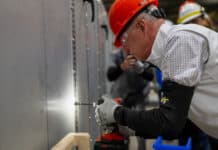By Warren Michelsen
From the November 2007 issue of Today’s Facility Manager magazine
Before sending soldiers into battle, a general marshals his top advisors, and together they devise a plan for victory. The same strategy lies behind the design-build method of construction.
Like the military, design-build is based on the concept of one leader backed by a team of experts who develop a master blueprint for a project and then work together to make it reality. The leader is usually a firm or a contractor/architect team that specializes in this project delivery method.
The design-builder contracts with the owner to provide all the architectural, engineering, and construction services on a project. Together, the owner and the design-builder agree on a maximum cost and establish a timeline for completion.
Design-build is an increasingly popular alternative to the traditional design-bid-build method, which, by definition, separates the key players in the construction process. Also, the design-bid-build bidding process focuses primarily on cost management; the emphasis is not on delivering the best building in the fastest time.
In design-build, the process is streamlined because there’s just one bid, one contract, and one design-builder who oversees everything at all times. Having one key decision maker also helps provide clear, accurate communications throughout the process, helping to prevent costly mix-ups and mistakes. In short, the power of one also reduces risk for others.
Those benefits are behind the rise of design-build. In 1985, just 5% of commercial construction projects employed the design-build method. By 2005, that number had risen to 40%. By 2015, design-build will capture 50% of the domestic, non-residential construction market, according to forecasts from the Design-Build Institute of America.
“Because of the benefits owners receive from design-build, the market is moving away from the traditional process of design-bid-build, in which the owner usually contracts with two entities whose relationship could become adversarial, to a process in which the owner only has one point of contact,” writes Martin Sell, AIA, in The Architect’s Guide to Design-Build Services (John Wiley & Sons, Inc., 2003).
The design-build method is based on the principle that a single source is the best source. According to the American Institute of Architects, this “single point of responsibility” offers numerous benefits, including better management of project costs, scheduling, and quality.
The focus on quality starts at the beginning of the process. In the design-build delivery method, the owner has the option to choose the design-build contractor through a “request for qualifications” rather than the “request for proposal” (RFP). The design-builder, in turn, usually selects contractors and subcontractors based on expertise, rather than lowest cost.
Once assembled, the project team works together during the design stage to select the best materials, equipment, and systems. This unified strategy produces more accurate cost estimates up front, reducing the risk of unanticipated overruns and expensive change orders.
After the documents are drafted, the design-builder verifies their quality and accuracy. This protects contractors from bearing the cost of unbudgeted, mid-construction changes.
If any alterations become necessary, they can be made more quickly and effectively because of the integrated team. The design-builder approves and communicates every decision to the contractors and subcontractors directly, rather than through a fragmented chain of command.
Time is money when it comes to construction, and the design-build method can deliver in both areas. It speeds time to completion by allowing the construction and design phases to overlap. Important steps—such as materials and equipment procurement, and initial construction work—can begin as the design phase is finalized rather than after all bids are in and approved.
This time-savings factor has fueled the boom in design-build construction. Along with commercial owners, government agencies are increasingly harnessing the benefits of design-build.
Faced with small budgets and short schedules on some public projects, lawmakers at the local, state, and federal level have recognized the shortcomings of the design-bid-build process. They have passed a wave of legislation authorizing the use of design-build for projects ranging from highways to schools.
During the past six years, state and city lawmakers in 45 states have passed more than 300 laws authorizing their agencies to take advantage of the design-build process. For example, California legislators last year voted to use the design-build method to help relieve some of the state’s legendary traffic congestion by widening Interstate 405.
“The design-build process saves time and money by allowing us to use one bidding process and one team to handle both the design and the construction,” explained Governor Arnold Schwarzenegger. “Design-build is also estimated to speed up the building process by a third.”
One reason is the cohesion of the design-build team. Working closely together, the project partners can make key decisions more quickly and execute them more effectively, often increasing savings to the owner.
Assembling a strong team is the key to success for design-builders. The following qualifications should be considered when facility professionals select contractors and subcontractors for a design-build team:
- Design-build experience. The most effective design-build partners have experience with the process. Strategic partners who work well within the framework of an organization should be retained.
- Glowing recommendations. Check out the credentials and job histories of those who want to join the team. Recommendations should be submitted by trusted sources.
- Expertise in the field. When building a bridge, a factory, or a college laboratory, each project requires distinct skill sets. Look for partners who are experts in their specialties, whether it’s HVAC or sheet metal.

Michelsen
Michelsen leads all equipment and controls sales with Trane’s engineer, contractor, and owner sales teams in the Western U.S. During his 15 years with the Piscataway, NJ-based company, he has held several key marketing and operations positions in air handling, chiller, and service businesses. For more on Trane, visit www.trane.com.






















![[VIDEO] Collect Asset Data at the Speed of Walking a Building](https://facilityexecutive.com/wp-content/uploads/2024/02/maxresdefault-324x160.jpg)